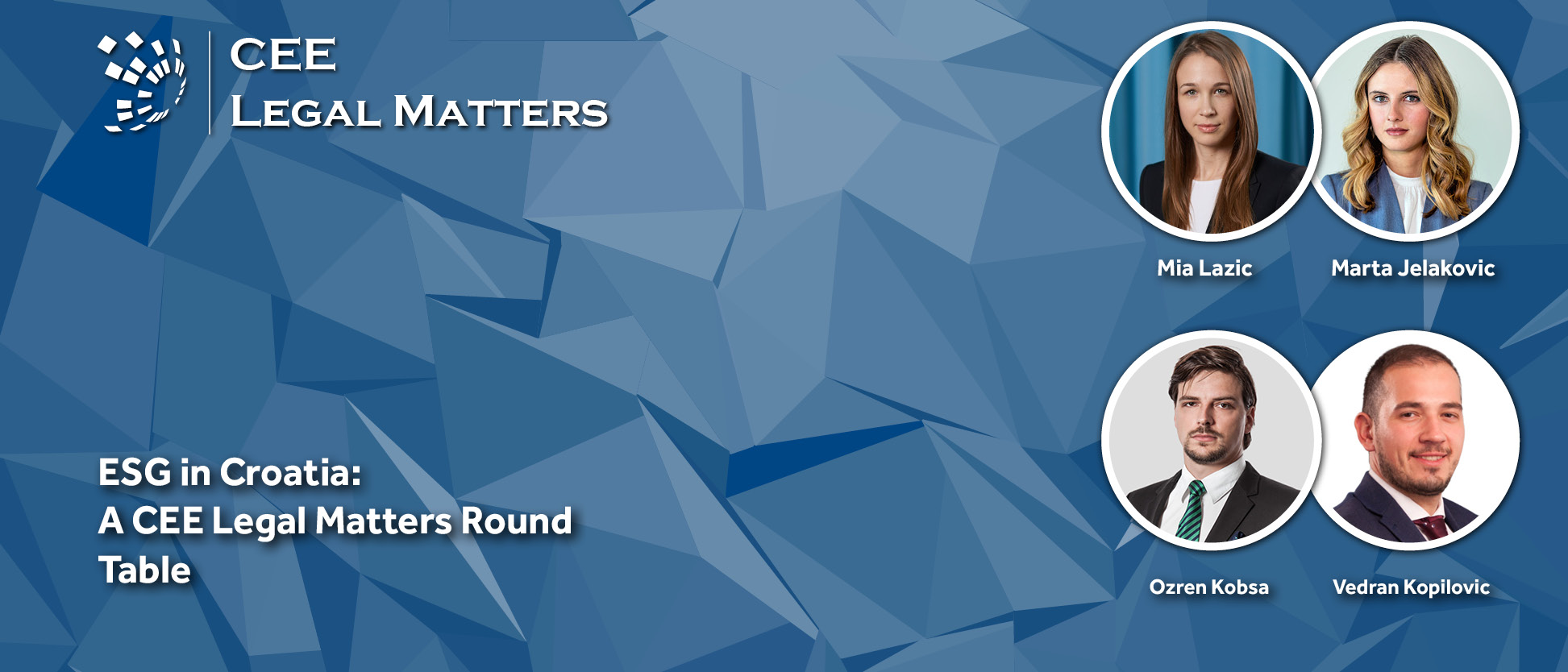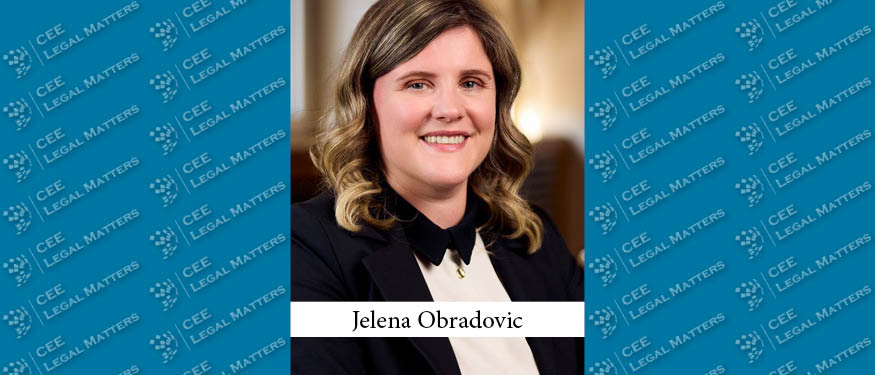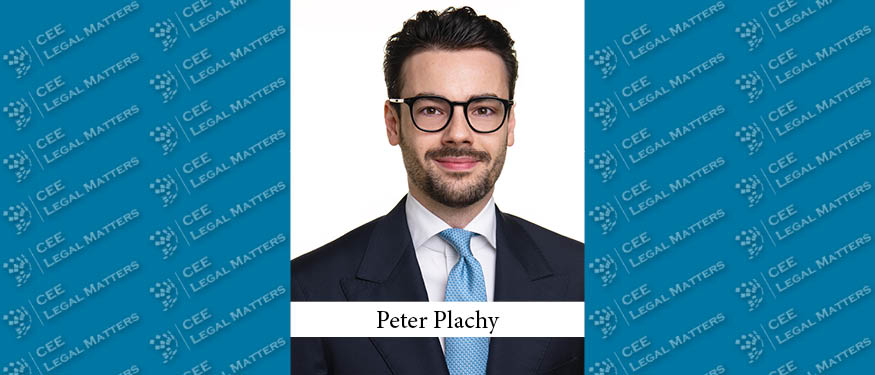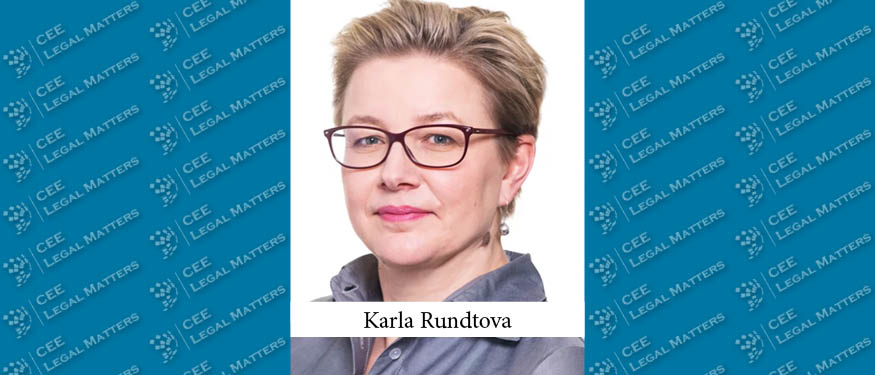On February 24, four leading lawyers in Croatia sat down for a virtual round table moderated by CEE Legal Matters Managing Editor Radu Cotarcea. The conversation focused on the current state of affairs of ESG in the country at the moment and the challenges of raising awareness in the topic.
Participants:
- Marta Jelakovic, Senior Associate, Ostermann & Partners
- Mia Lazic, Partner, Savoric & Partners
- Ozren Kobsa, Attorney at Law in cooperation with Schoenherr
- Vedran Kopilovic, Senior Associate, Zuric i Partneri in cooperation with Kinstellar
You can also listen to the conversation as a podcast below.
CEELM: What is your understanding of ESG? What do you think it means relative to the specific local Croatian realities?
Kopilovic: Developing the ESG legislation in Croatia, as a member of the EU, is crucial for the economy and future sustainable development.
There is a set of regulations and directives set by the European Parliament that have been integrated into the Croatian legislative system – to name some: a non-financial reporting directive, an independent accounting act, the new taxonomy regulation, sustainable finance disclosure regulation, low carbon benchmark regulation.
Now, when it comes to ESG reporting, Croatia is in the early stages. ESG reporting should develop more in the years to come, but, there is a positive trend, in addition to there being some companies that are required to report and disclose ESG-related factors in their financial reporting. According to official statistics, 40% of companies that are not obligated to publish non-financial reports, are in fact doing this.
This is a positive trend that makes other companies and entities participating in the Croatian market see the positive effects of ESG compliance. Obviously, there is room for development, but seeing as how all of this is in its early stages, it stands to reason that there is a lot of work ahead of us before we fully achieve the EU 2050 plans.
CEELM: Aside from there being local implementation, is there anything still pending on the EU level?
Lazic: Not at the moment. Main pieces of legislation have been completed, from the taxonomy onward. We are not aware of anything that should be further implemented at this point, in Croatia. In my view, there is still quite a lot of room to raise awareness of the ESG, though. I believe this will be the main topic in the next years, for businesses and banks alike.
ESG is becoming a strong topic in Croatia, but it is still quite new – and it is not as prominent as it is in other countries. Croatia, currently, has no commercial banks offering green financing – it’s mainly state-owned banks doing this, working on green loans in cooperation with the EIB.
Generally looking at it all, as lawyers, we see that there is still room to improve ESG awareness levels on the local stage. Foreign investors are paying more attention to ESG when doing their due diligence while looking to invest. Also, there is a strong influence of international finance institutions that trickles down to local banks, requiring a higher level of ESG compliance.
Kobsa: I understand why Mia underlines a lack of understanding or awareness. The market is still in a process of collecting data. There is a regulatory tsunami coming up for Croatia, trying to catch up with all of the newest EU trends – all of which are developing at such a high speed.
Data gathering and reporting – this is becoming a new normal, making these times quite interesting for doing business. Also, reporting obligations and strong ties that Croatian companies have with EU financing sources and ownership structures. This helps as there is a push from abroad.
Still, Croatian banks are still processing how best to create specific market products – the problem is that there is not enough of a demand in the market. When you have strong demand from the market, it is easy for you to calibrate a product. If I had to choose a good example in this regard, however, it would be that retail housing loans are increasingly green now and I believe that more of this type of trend is yet to come.
CEELM: Ozren, you mentioned retail financing and Mia mentioned banks – is green funding a reality, yet?
Jelakovic: As Ozren said, green housing loans are quite common seeing as how there is a high level of both demand and supply in that regard.
We’ve seen some long-term loans for investments in transportation and renewable energy, and there’s also project financing available for projects with a measurable environmental impact. A big part of the financing comes from the EU and as a consequence of the Croatian Bank for Reconstruction and Development’s cooperation with the EIB.
At the start of last year, there has been a memorandum of understanding between the EIB and the Croatian Ministry of Economy and Sustainable Development, to finance more projects. Still, results are yet to be seen.
As it is right now, there aren’t that many green financial products, but there are good capital market examples like the Erste Bank EUR 400 million green bond which was issued in 2021. I hope this positive trend continues.
Additionally, as everyone already said, Croatia has mostly harmonized with the EU legislation, but when it comes to applying this legislation and having a high level of awareness – the reality is a bit different. In some ESG country ratings, we can see that North European countries like Sweden, Denmark, and Finland are outperforming the rest, while the East European countries still have a lot of room for practical improvement, even with, theoretically, a strong starting position.
Tourism and the beautiful environment are a crucial competitive advantage of the Croatian market yet, every year, Croatia loses approximately EUR 150 million due to the environmental impact of tourism. Marine littering, air pollution – these could be a good place to start.
CEELM: Following up on the examples of green financing from banks – are mainly international banks doing this?
Kobsa: I believe there were a couple of Austrian banks tied to some funding last year, however, these are not green bonds as they would be understood in the EU. It’s just that a part of the funds will be used towards raising awareness of green investments in Croatia. I didn’t see any standardized green loans, however, it should happen this year. Of course, from local banks that are directly tied to foreign banks.
CEELM: What do you feel needs changing, either regulatory-wise or for the capital markets themselves for this to be a reality?
Kobsa: Knowledge brings opportunity. We are still in preparatory phases – the Croatian Central Bank has but 1% of its portfolio in ESG while, in other markets, there is an explosion in green financing and backing up portfolios in ESG.
Kopilovic: I agree, I think we need to raise awareness of the importance of ESG compliance full-market-wide, in Croatia.
Most entities that are disclosing their ESG compliance are those obligated by law to do so. Being obligated by law to do this, one may argue that they are completely aware of the inherent importance of this compliance. The true value of this would be reflected in other companies, that do not have such an obligation, to start reporting on ESG compliance. There is a lack of awareness of what ESG compliance can do for the Croatian economy.
There are some green investment funds, like Erste Bank and Raiffeisen Bank, but these are not local products but are related to parent companies abroad. I wouldn’t say that there is a complete awareness of even the banks of how green financing could improve their business and attract new investors, for example, millennial investors.
Jelakovic: Following up on what was said about investment funds and banks – some of them do offer investments that are said to be green and sustainable. However, the structure of the funds is not publicly available, or even when it is – you can see that some of the green funds mostly invest in the same companies as non-green funds. So the criteria of investing must be more transparent.
For example, I’ve even seen an investment fund, from OTP, publicly stating that they do not include sustainability risks in their calculus processes because they don’t find it relevant at the moment. From one perspective, that’s ok, they probably do not have enough information to assure the investors that they have the requisite ESG refinement, or maybe their investors simply care more about financial returns than they do about ESG factors. Either way, it’s certainly more transparent behavior, which is, ultimately, a good thing.
Kopilovic: I agree completely. I was speaking to an investment firm recently, regarding some potential green investments and what could be expected in the short and long term. What I got from the other side was “yes, this is good for the environment, and is not a bad investment decision, but why don’t you invest, instead, in another portfolio that has much higher returns.”
So, as you can see, even investment companies, when approached, do not express as high of support of green investing as they should, at least following EU policies and green strategies.
CEELM: Do you think that’s just a matter of awareness? Or is there simply not a business case for it right now? If not right now, when do you think it will change?
Kopilovic: When and how these changes will occur I’m not completely certain, but we must work on educating market players in Croatia about the importance of ESG compliance and, perhaps via state authority, give some incentives for complying with environmental and other regulatory standards.
Kobsa: This is a generational gap, I believe. For younger generations, the environmental part needs not to be underlined, in terms of its importance – in any aspect, not just when it comes to financing.
Still, opportunities need to be pointed to, like cost reductions. State-owned companies, like utility and transportation companies and across all sectors, really, are facing a wide plethora of opportunities that they could explore. I’m surprised that, for older generations, these opportunities need to be highlighted and pointed to strongly.
CEELM: Mia, what would you say are the main question marks prior to the introduction of the taxonomy? And, looking at the current status, are there any questions left over?
Lazic: Before the Taxonomy Regulation, the companies could say that something is sustainable and market it that way and no one would know better. The Taxonomy Regulation cleared up what sustainable means and created a unified approach. It allows less space for misusing ESG terms and it also brought in a lot of clarity in regulatory aspects.
In the ESG sector, like in other sectors, there are still issues in practice and many further compliance aspects need to be introduced. It is difficult for companies to adapt very fast, even those that wish so. Since ESG compliance will be important in the coming years, this places an important role on us, as lawyers, in guiding our clients on this journey.
I agree that we are a different generation and that ESG awareness will follow with each next generation. Still, most businesses today are led by profit, and ESG compliance can be an extra cost to many of them, even for those that are led by ESG goals. I believe that everyone will have to adopt ESG goals if they wish to have access to finance, to investors. In a few years, it would be very difficult to get financing otherwise.
Kobsa: What we can see from the questions coming in from local and foreign businesses alike is that there is a distinction between green and sustainable. There is a lot of semantics misuse here – whether a green loan is a sustainability-linked one – and it is difficult to understand the differences here.
Also, there is a question of how to quantify profits when giving green financing. There is also the matter of tailoring representations and warranties, which is an important thing finance-wise – what data is good data for KPIs and financial arrangements and could be used with trust.
Jelakovic: I’d like to say that the taxonomy unified some terms in this field and it will take time for clients and companies to absorb them all. NFRD, SFDR, it’s all just an alphabet soup for someone hearing it for the first time.
One of the issues that remain, however, is a lack of unified standards. How reliable the data is, or if it can be compared cross-companies. There are several sets of standards and companies need to know which one to use. At this time, most companies use the GRI standards.
So it’s not just about the availability of data but also about the ability to compare it adequately.
Also, I’ve noticed that some companies raised the issue of increasing ESG compliance will also increase prices. I saw an oil and gas article recently, citing that this would be a heavy burden for their businesses and that excess costs might be exported to the consumers.
CEELM: Is it the reporting costs or is it the environmental standards themselves which prove difficult to manage?
Jelakovic: It’s about the standards. Reporting is not that much of a problem – most companies required to report are already quite versed in it. But, is there data embellishing, is the energy efficiency actually increasing, what about human rights? It requires extra effort to actually achieve the standards, so this is what might raise costs – the compliance of the business itself, not the reporting.
Kopilovic: This is the goal of a green-orientated and sustainable economy.
When talking about investments, from a profit perspective, most are, indeed, profit-led. If you’re guiding values for investing are environmental concerns and sustainability, chances are you don’t think about profits as much – which could demotivate investors to invest in green bonds and green investment funds.
This is, long term, a bad decision – all resources, sooner or later, will be reworked into ESG-compliant business streams – which will generate much more profit in the future compared to business flows that will have to make the switch later down the line.
CEELM: To what extent are foreign investors attentive to ESG?
Kopilovic: Honestly, not many of the investors that we’re working with right now are worried about ESG compliance.
In western European countries, ESG awareness is at a higher level than in Croatia, without a doubt. A general lack of awareness in Croatia about what ESG could mean in the future is something to worry about.
Jelakovic: I agree that foreign investors seem to be more aware and cautious regarding ESG standards.
Speaking from an M&A and due diligence perspective – if the transaction/investment takes place in an industry that is potentially damaging for the environment, like the oil industry, investors take a stronger note of ESG. Conversely, if it’s a gaming industry deal, where there is a higher risk of money laundering, investors will pay more attention to AML compliance. If the transaction involves a huge number of workers, then attention to labor laws and safety regulations is paramount and takes the center position.
It’s still within the standard transactional framework of due diligence – to ensure compliance and to avoid monetary fines – not to make sure that more attention is paid to ESG as such. It’s all, mainly, just to fulfill the minimal legal requirements.
Also, sometimes it depends on the industry which the investor is coming from and the experience the investors had from before. For instance, we’ve noticed an increased level of awareness with technology companies.
Kobsa: There is a definite interest from abroad, but probably not enough and not the same on the ESG level. I think that the environmental part is much more in focus than, for example, the social part. There are not a lot of talks about sick leaves, social inequalities, lost time… it’s not that it is not understood – it is, but it is not discussed (as much as environmental aspects).
Lazic: In our experience, an increasing number of foreign investors look at ESG in M&A transactions. Internal compliance levels of their business could be the reason why, but also because it affects the value of the company they want to invest in or acquire.
Still, ESG is not a focal element in a due diligence process and a decisive factor for investors when choosing a target.
On the contrary, we very rarely see local investors interested in ESG matters, probably due to a lack of awareness of these topics. This will change in the future for sure, but there is not a lot of local companies concerned about it now.
CEELM: Access to investors as well as potential green financing motivates companies to adopt an ESG-friendly/green approach to business. Based on what I hear so far, neither seem to have left a particular mark in the country. So, are there companies going green as a consequence of the ESG movement?
Kopilovic: There have been some improvements in this respect. From the perspective of the lawyers, it is difficult to ascertain how companies do this internally, but there are a lot more requests and questions related to ESG compliance – particularly related to sustainability requirements and processes.
Following this interest, companies are trying to implement all of the relevant regulations in their internal processes, as much as possible.
The questions we get are mostly related to extended product manufacturer responsibilities, conflicting mineral regulations, and green standards for public procurement procedures. These three areas have been visible to us the most, but, really, it depends on the industry if these have an impact or not.
Kobsa: With the companies are going green due to their obligations under the SFDR and NFRD, the financial sector and listed companies are, of course, in a tighter focus currently. These companies have been preparing for the change for the longest time.
What I can see, from experience and incoming mandates alike, is that almost all companies are setting up internal processes, compliance procedures, and obligation lists in this regard. Compliance officers have a full plate on their menu when it comes to things to take into account.
Also, it depends on the sector of the business we’re observing – for example in healthcare, safety, or transportation – ESG has been a constant measure for a much longer period of time. Not to mention how this will be a hot topic for the insurance sector – how to adapt the risk evaluation processes when granting an insurance policy or what happens if it is breached.
Jelakovic: I would just like to reiterate, also, that reporting is not a problem, but general compliance is. In reports, most companies declare that they invest a part of their funds in recycling endeavors or emission reduction. However, only 18% of companies report on their water consumption, and only one company provided data on their wastewater reduction. So we’re seeing plenty of standards, and principles, but at this point, we don’t see much evidence that something is being done, systematically.
We haven’t had so many inquiries from clients since I don’t think that the awareness is there just yet. One should also have in mind that there are only 100 or so issuers on the Zagreb stock exchange that are actually required to report. There is a positive trend though, as there is a noticeable number of companies that published their non-financial reports voluntarily.
CEELM: How do you all see the role of lawyers in Croatia being influenced by ESG, if at all?
Kobsa: Lawyers can and should be at the center of ESG development, playing a very important role there. However, ESG factors are dependent on numerous things – social, environmental, market factors. We are pretty much well positioned to take a great part in this multidisciplinary playing field of producing and importing regulatory approaches for ESG agendas.
Companies nowadays need to consider and evaluate the impact of ESG factors on their day-to-day business. Especially from a risk standpoint – regulatory, legal, business, reputational, market risks, and the like, specifically in the form of incoming claims or shareholder relation changes. A lawyer’s skillset, analytical approach, evidence-based assessment capabilities – I think we can really be great assets.
Jelakovic: I agree absolutely. From my perspective, it’s logical that clients turn to lawyers, it all starts from national laws and EU legislation. A multidisciplinary approach will be necessary and is already very helpful.
We need to cooperate with experts from various fields, like accounting and human resources, and educate ourselves in this regard. Raising awareness with the clients, clarifying why they ought to be compliant, and going above the minimum legal requirement thresholds. The more data a company publishes and the more it tries to comply as best it can with ESG standards – the better it will be for its business and give them a competitive advantage.
CEELM: Finally, not focusing only on legislative updates to keep an eye on, are there any items on your wish list to move ESG forward in Croatia?
Lazic: In terms of legislation, I think it is best, for now, that Croatia closely follows the EU level of legislation and remains updated. I hope we continue with the current trends. More of this emphasis should be placed on implementation and how it works in practice – raising awareness of ESG and all benefits it can bring. Not just large businesses, but also smaller ones.
More green products and financing options are great opportunities to help in raising awareness that ESG compliance could bring great value.
We’re hoping for this to become even more important in the next few years and that all will take a closer look at ESG and try to improve their compliance levels immensely.
Kopilovic: I think that the new EU directive on corporate sustainability reporting is expected to pass in 2023. With it, we will take a step forward and extend the list of companies required to report finances and ESG.
On a local level, there are not many activities at the moment. There are initiatives to pass regulations that would provide more detail, for example in conflict mineral regulations, but this is all in the early stages. We are monitoring the situation, this is of high importance to us.
In relation to future steps and actions, in Croatia, I think that this should be done in a way so as to raise awareness of ESG importance and to motivate investors to pursue green-orientated companies and targets.
Jelakovic: As we’ve already heard so much, Croatian legislation is based on EU legislation, so there are not that many proposals at the moment, to the best of my knowledge. It’s all mostly EU harmonization, reducing undeclared work situations, or having more rules for controlling the quality of drinking water.
I feel that we have enough legislation, but now we need a strong application of them as well as to educate the market.
Also, it is necessary to prevent greenwashing and regulate it – if not sanctioning those who use this for profit, there will be a chilling effect on those trying to make a difference.
Kobsa: This is still making an impact in the investment funds sector, right now – I’m hoping to see participants from other industries going in the same direction.
We are closely looking at RTS that are coming in, hopefully soon under SFDR and the new taxonomy regulation. I was very happy to see the Croatian National Bank developing its own strategy in which they include environmental and climate risks in the supervisory processes. Knowing the bank, they will encourage other institutions to include this in their risk management and decision making too.
Also, with regards to the Croatian financial regulator – I’m also hoping to see a change with respect to corporate bonds – there are rumors that green corporate bonds are coming to the market soon. Sovereign bonds, green sovereign bonds – this would definitely show the dedication and readiness of the country for ESG.
I think that we could, of course, do more and push more, looking at the EU trends right now.
















